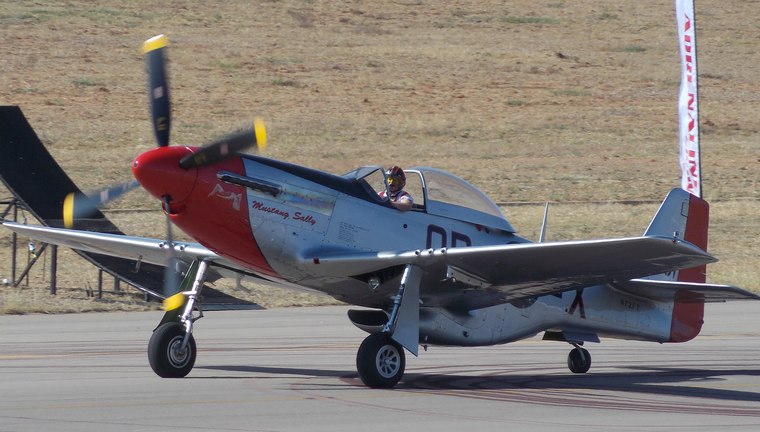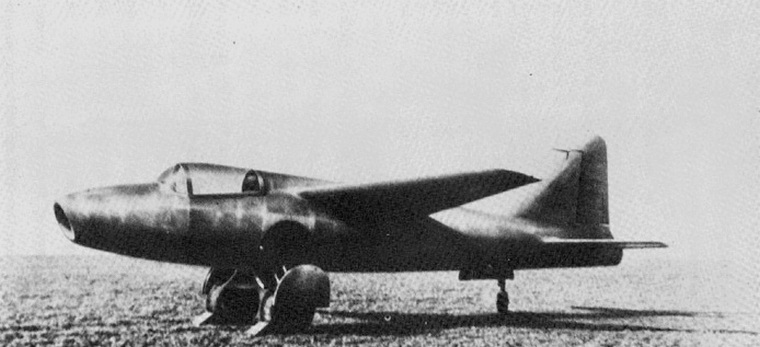












Fighter Advancements during the Second World War
By Amith Babu
Between the years of 1939 and 1945 the planet saw the most devastating conflict in human history, leaving no corner of the world unstirred. In a state of full scale war both sides threw their entire economic, industrial, and scientific capabilities at the war effort civilian and military resources became indistinguishable. A great number of improvements were brought to the world of aeronautics that by the end of the war the dawn of space flight was appearing, but the greatest change wasn't the creation of new technology but the perfection of already existing technology, aircraft became faster, more powerful and more complex.

The P-51 is one of the most admired aircraft in the world, shown above is Mustang Sally, Serial Number 44-74494. Photo © Author.
Air superiority was vital, if you were able to win the battle in the air you were almost guaranteed to win the battle on the ground. Fighters before the war such as the Messerschmitt Bf109 had a monocoque design which had a severe drawback, stress was carried by both the skin and skeleton, if the aircraft's skin were to get damaged (which is quite common with bullets flying around) the aircraft may not be able to hold itself together. Whereas newer fighters such as the North American P51 Mustang and Supermarine Spitfire were made using a semi-monocoque structure, which meant stress was carried by the airframe skeleton enabling them to handle stress far better making them more maneuverable and carry heavier loads whilst taking a beating.
The first few models of the Spitfire had fabric covered control surfaces but combat experience proved impossible to use at high speeds, the Hawker Hurricane had a fabric covered fuselage which limited its capabilities thus its wings were changed to a stressed-skin of duralumin, as with the Spitfire's control surfaces; greatly increasing both aircraft's performance. The combination of stressed skin and a semi-monocoque structure proved exceptional, now almost every aircraft uses a metal semi-monocoque design.
Engines advanced steadily throughout the war, engine makers such as Rolls Royce and Daimler-Benz increasing piston engine power outputs to almost half to their predecessor's. However this proved to be not enough as aircraft from the both sides of the war could compete with each other, leaving just the skill and experience of the pilots on the table. Hence both sides needed a game changing airplane and from that came the development of 2 jet fighters, the Gloster Meteor and the Messerschmitt 262.

Heinkel He 178 Photo commons.wikimedia.org

Gloster Meteor Photo Ruth AS/commons.wkikmedia.org
Hans von Ohain is credited for building the first operational jet engine, though a working idea was created by Frank Whittle first, who at the age of 22 submitted a patent for a TurboJet Engine, which was later granted in 1932.von Ohain's engine was used on the Heinkel He 178 and successfully flew a week before the invasion of Poland, which convinced the Germans to adopt jet engines for its top secret advanced fighter which was under development before the war had even begun, which would later be the Messerschmitt 262. Von Ohain however had no influence in the construction of the 262s engines. By 1941 the aircraft began test flying and development from the initial prototype to the production model would take 3 years, it would be the world's first jet fighter, claiming 542 allied aircraft, though at a cost. The 262 was rushed into production; Germany was running low on resources and the aircraft engines, two under-wing Junkers Jumo 004 B-1 turbojets, proved very expensive and unreliable. The 262s design featuring swept wings and NACA Airfoils was revolutionary, the aircraft was highly maneuverable right up to never exceed speed.

Messerschmitt Me 262A Photo www.nationalmuseum.af.mil/commons.wikimedia.org
The 262's counterpart, the Gloster Meteor, had begun development in 1940. The Meteor first flew in 1943 and commenced operations on 27 July 1944. The Meteor saw very little action because of fears of it crashing over enemy territory and its technology being studied. It was mainly used for training purposes and to shoot down V-1 rockets, in one case the where a pilot tipped a V-1 off course after the aircraft's cannon jammed. The Meteor was also used for research and development purposes and broke several aviation records. It wasn't an especially aerobatic airplane, having a simple yet reliable design, however the British had the advantage of being able to evaluate and improve the Meteor, making several models and all packed with technology, this led it to become a largely successful fighter especially after the war where it served with various nations and to this day is still being used for research. Captured 262s will go on to be analysed and would influence many post-war fighters such as the F-86 Sabre Jet aircraft would not be where they are today without the research and hard work put into these 2 fighters in such a short period of time.

The P-51 is one of the most admired aircraft in the world, shown above is Mustang Sally, Serial Number 44-74494. Photo © Author.
Air superiority was vital, if you were able to win the battle in the air you were almost guaranteed to win the battle on the ground. Fighters before the war such as the Messerschmitt Bf109 had a monocoque design which had a severe drawback, stress was carried by both the skin and skeleton, if the aircraft's skin were to get damaged (which is quite common with bullets flying around) the aircraft may not be able to hold itself together. Whereas newer fighters such as the North American P51 Mustang and Supermarine Spitfire were made using a semi-monocoque structure, which meant stress was carried by the airframe skeleton enabling them to handle stress far better making them more maneuverable and carry heavier loads whilst taking a beating.
The first few models of the Spitfire had fabric covered control surfaces but combat experience proved impossible to use at high speeds, the Hawker Hurricane had a fabric covered fuselage which limited its capabilities thus its wings were changed to a stressed-skin of duralumin, as with the Spitfire's control surfaces; greatly increasing both aircraft's performance. The combination of stressed skin and a semi-monocoque structure proved exceptional, now almost every aircraft uses a metal semi-monocoque design.
Engines advanced steadily throughout the war, engine makers such as Rolls Royce and Daimler-Benz increasing piston engine power outputs to almost half to their predecessor's. However this proved to be not enough as aircraft from the both sides of the war could compete with each other, leaving just the skill and experience of the pilots on the table. Hence both sides needed a game changing airplane and from that came the development of 2 jet fighters, the Gloster Meteor and the Messerschmitt 262.

Heinkel He 178 Photo commons.wikimedia.org

Gloster Meteor Photo Ruth AS/commons.wkikmedia.org
Hans von Ohain is credited for building the first operational jet engine, though a working idea was created by Frank Whittle first, who at the age of 22 submitted a patent for a TurboJet Engine, which was later granted in 1932.von Ohain's engine was used on the Heinkel He 178 and successfully flew a week before the invasion of Poland, which convinced the Germans to adopt jet engines for its top secret advanced fighter which was under development before the war had even begun, which would later be the Messerschmitt 262. Von Ohain however had no influence in the construction of the 262s engines. By 1941 the aircraft began test flying and development from the initial prototype to the production model would take 3 years, it would be the world's first jet fighter, claiming 542 allied aircraft, though at a cost. The 262 was rushed into production; Germany was running low on resources and the aircraft engines, two under-wing Junkers Jumo 004 B-1 turbojets, proved very expensive and unreliable. The 262s design featuring swept wings and NACA Airfoils was revolutionary, the aircraft was highly maneuverable right up to never exceed speed.

Messerschmitt Me 262A Photo www.nationalmuseum.af.mil/commons.wikimedia.org
The 262's counterpart, the Gloster Meteor, had begun development in 1940. The Meteor first flew in 1943 and commenced operations on 27 July 1944. The Meteor saw very little action because of fears of it crashing over enemy territory and its technology being studied. It was mainly used for training purposes and to shoot down V-1 rockets, in one case the where a pilot tipped a V-1 off course after the aircraft's cannon jammed. The Meteor was also used for research and development purposes and broke several aviation records. It wasn't an especially aerobatic airplane, having a simple yet reliable design, however the British had the advantage of being able to evaluate and improve the Meteor, making several models and all packed with technology, this led it to become a largely successful fighter especially after the war where it served with various nations and to this day is still being used for research. Captured 262s will go on to be analysed and would influence many post-war fighters such as the F-86 Sabre Jet aircraft would not be where they are today without the research and hard work put into these 2 fighters in such a short period of time.
 |
 |
 Copyright © 2024 Pilot's Post PTY Ltd
The information, views and opinions by the authors contributing to Pilotís Post are not necessarily those of the editor or other writers at Pilotís Post.
Copyright © 2024 Pilot's Post PTY Ltd
The information, views and opinions by the authors contributing to Pilotís Post are not necessarily those of the editor or other writers at Pilotís Post.